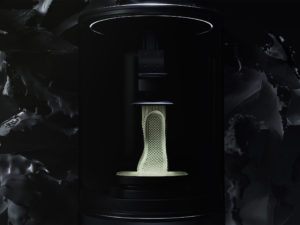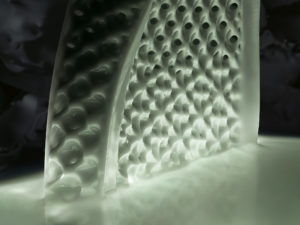With 3D Printing Technology from Carbon, Adidas Releases First Partially 3D Printed Athletic Shoe to Be Produced at Scale
 In December of 2016, Adidas released the 3D Runner, a limited-edition, $300 running shoe with a 3D printed midsole; the company had been looking toward 3D printing solutions for its shoes since 2015, including working with recycled ocean waste. Adidas is among the ranks of other big-name manufacturers such as Nike, Reebok, New Balance, and Under Armour, which have also designed and released athletic shoes with 3D printed components. Although 3D printing is becoming more popular in the manufacture of footwear – particularly athletic shoes – it’s still not exactly what I would call accessible. The aforementioned companies have, for the most part, been offering their 3D printed kicks for a high price tag and/or a very limited production run, because for all the advantages it offers, 3D printing still hasn’t quite arrived at the level of mass production.
In December of 2016, Adidas released the 3D Runner, a limited-edition, $300 running shoe with a 3D printed midsole; the company had been looking toward 3D printing solutions for its shoes since 2015, including working with recycled ocean waste. Adidas is among the ranks of other big-name manufacturers such as Nike, Reebok, New Balance, and Under Armour, which have also designed and released athletic shoes with 3D printed components. Although 3D printing is becoming more popular in the manufacture of footwear – particularly athletic shoes – it’s still not exactly what I would call accessible. The aforementioned companies have, for the most part, been offering their 3D printed kicks for a high price tag and/or a very limited production run, because for all the advantages it offers, 3D printing still hasn’t quite arrived at the level of mass production.
 That may change very soon, though. Today, Adidas is introducing a new partially 3D printed shoe made, according to the company, with light and oxygen. No, it didn’t involve reverse-engineering photosynthesis – it involved Digital Light Synthesis, the process behind Carbon‘s now-famous CLIP technology. Digital Light Synthesis combines digital light projection with an oxygen-permeable environment and programmable resins to create strong, durable, high-performance polymer parts – in this case, a lattice-printed insole that forms the core of the new Adidas Futurecraft 4D.
That may change very soon, though. Today, Adidas is introducing a new partially 3D printed shoe made, according to the company, with light and oxygen. No, it didn’t involve reverse-engineering photosynthesis – it involved Digital Light Synthesis, the process behind Carbon‘s now-famous CLIP technology. Digital Light Synthesis combines digital light projection with an oxygen-permeable environment and programmable resins to create strong, durable, high-performance polymer parts – in this case, a lattice-printed insole that forms the core of the new Adidas Futurecraft 4D.
The collaboration marks the first time that Carbon’s technology has been used in the performance footwear industry, and Adidas intends for it also to be the first time that 3D printed athletic footwear has been produced at scale. The current goal is to produce 100,000 pairs of Futurecraft 4D shoes by 2018 and then continue to scale up production into the tens of millions. It’s definitely doable; not only does Digital Light Synthesis/CLIP allow for super-fast 3D printing, it also speeds overall production by eliminating the prototyping stage altogether. As Carbon continually demonstrates, they are offering technology for complete manufacturing solutions, and are optimistic about growth prospects.
“Despite the influence of technology to improve almost every other aspect of our lives, for eons the manufacturing process has followed the same four steps that make up the product development cycle – design, prototype, tool, produce. Carbon has changed that; we’ve broken the cycle and are making it possible to go directly from design to production,” said Dr. Joseph DeSimone, Co-Founder and CEO of Carbon. “We’re enabling engineers and designers to create previously impossible designs, and businesses to evolve their offerings, and FutureCraft 4D is evidence of that. Our partnership with adidas will serve as an ongoing testament to how the digital revolution has reached the global manufacturing sector, changing the way physical goods are designed, engineered, made, and delivered.”
 To design the Futurecraft 4D midsole, Adidas compiled 17 years’ worth of running data to create an optimal shape for runners, a shape that will be further customized to individuals. (That’s where the 4D comes from; Adidas calls athlete data the fourth dimension of the 3D product design process.) Every customer’s individual needs will be addressed in terms of comfort, stability, cushioning, and movement. Adidas plans to release 300 pairs of Futurecraft 4D shoes to friends and family this month, followed by 5,000 more pairs for retail in fall/winter 2017. Then the real mass production will begin.
To design the Futurecraft 4D midsole, Adidas compiled 17 years’ worth of running data to create an optimal shape for runners, a shape that will be further customized to individuals. (That’s where the 4D comes from; Adidas calls athlete data the fourth dimension of the 3D product design process.) Every customer’s individual needs will be addressed in terms of comfort, stability, cushioning, and movement. Adidas plans to release 300 pairs of Futurecraft 4D shoes to friends and family this month, followed by 5,000 more pairs for retail in fall/winter 2017. Then the real mass production will begin.
The partnership with Carbon will go beyond Futurecraft 4D; the two companies will continue to work together in the future to develop new materials, machinery, and ultimately new products. Digital Light Synthesis will become one of the prime technologies used in Speedfactory, the smart factory that Adidas opened at the beginning of the year, so customers can expect more products in the future to be tailored to their individual needs.
“With Digital Light Synthesis, we venture beyond limitations of the past, unlocking a new era in design and manufacturing,” said Eric Liedtke, Adidas Group Executive Board Member Responsible For Global Brands. “One driven by athlete data and agile manufacturing processes. By charting a new course for our industry, we can unleash our creativity- transforming not just what we make, but how we make it.”
Discuss in the Adidas forum at 3DPB.com.
Subscribe to Our Email Newsletter
Stay up-to-date on all the latest news from the 3D printing industry and receive information and offers from third party vendors.
You May Also Like
Gorilla Sports GE’s First 3D Printed Titanium Cast
How do you help a gorilla with a broken arm? Sounds like the start of a bad joke a zookeeper might tell, but it’s an actual dilemma recently faced by...
Nylon 3D Printed Parts Made More Functional with Coatings & Colors
Parts 3D printed from polyamide (PA, Nylon) 12 using powder bed fusion (PBF) are a mainstay in the additive manufacturing (AM) industry. While post-finishing processes have improved the porosity of...
$25M to Back Sintavia’s Largest Expansion of Metal 3D Printing Capacity Since 2019
Sintavia, the digital manufacturing company specializing in mission-critical parts for strategic sectors, announced a $25 million investment to increase its production capacity, the largest expansion to its operations since 2019....
Velo3D Initiates Public Offering in a Bid to Strengthen Financial Foundations and Drive Future Growth
Velo3D (NYSE: VLD) has been among a number of publicly traded 3D printing firms that have attempted to weather the current macroeconomic climate. After posting a challenging financial report for 2023,...


































